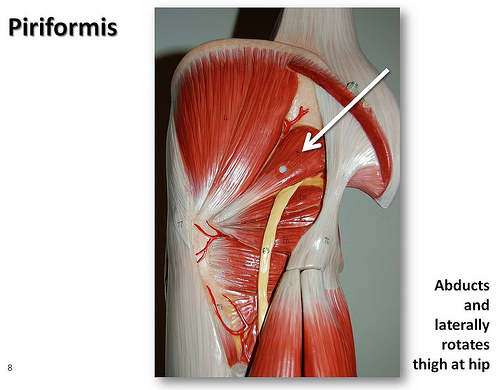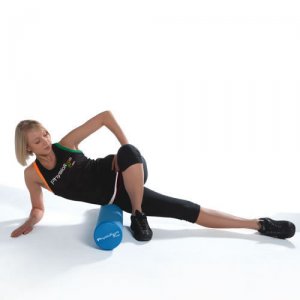The Bane of Every Runner’s Life – Piriformis Syndrome Exercises
Running can be a pain in the butt sometimes. If it’s not blisters, it’s niggling knees or misfiring quadriceps. And this weekֳ flavour is just as consuming: Piriformis syndrome. Equally as annoying standing up as it is sitting down, the condition can be pretty debilitating if not treated with the correct amount of humility and care. Piriformis syndrome exercises have become commonplace in many stretching routines such as my own. Yet still, the blighters hurt.
What is the piriformis?
The piriformis muscle, Latin for pear shaped is a, you guessed it, pear-shaped deep muscle which is located in the gluteal (bum) region of the leg. Connecting the lower spine, or sacrum, to the femur (big leg bone) the piriformis has a number of uses.[1]

In charge of lateral rotation of the femur and abducting hip flexion, the piriformis is an important functional muscle when everyday actions such as walking, jogging or sitting take place. Which is great if, like me, you are a runner who works in an office all day. Just great.
What is piriformis syndrome?
Piriformis Syndrome is a condition whereby the piriformis muscle (no points for guessing that) become irritated and compresses the sciatic nerve.[2]
Commonly mistaken as sciatica due to the compress of the sciatic nerve, the condition is best exemplified by a dull ache in the buttocks, pain through the sciatic nerve, reduced range of motion and misfiring of the quadriceps. Or, if like me youֲe really unlucky Рall of the above! In the latter stage of this article we will talk about piriformis syndrome exercises, but for now an accurate diagnosis and treatment method is needed.
Symptoms & diagnosis
So, your butt hurts and itֳ graduated to the lower spine. Though at times it may feel like you are slowly turning into the Hunchback of Notre Dame, unless you have had some sort of impact or trauma, the chances are youֲe not going to. So stop singing.
Of course, there are a variety of different possibilities with regards to conditions effecting this area but the big three; radiating pain in the buttocks which can include the leg or hamstrings, reduced range of motion in the hip and sciatic pain which can gravitate to the lower back.
The latter symptom is one of the primary reasons for the condition being confused as sciatica. This is because the piriformis invades the sciatic nerveֳ airspace, crushing the nerve and causing pain in the process.[3]
What you gonՠdo about it?
Like all sports based injuryֳ piriformis syndrome exists on a continuum scale of pain depending on the severity of the strain. For some, the chronic pain may be enough to prevent intense movements such as found when running or climbing stairs. For others, the sensation may only be enough to halt activities in the short term. Naturally, the severity of the injury will determine the functionality and type of rehabilitation available to you so listening to your body is the utmost of priorities.
Treatment
The first port of call, as with most injuries is to rest the affected area as much as possible. That doesnִ mean not to move or not to even play sport but by supporting the core and gluteals, the piriformis will be given a chance to repair itself. Only then can piriformis syndrome exercises be undertaken. Lumbar support systems such as the PhysioRoom.com Elite will keep the core engaged and supported without causing unnecessary stress on the lower lumbar region of the spine and the sciatic nerve.
Foam rollers such as the PhysioRoom.com Rum-Tech are exceptionally useful once the injury is in the rehabilitation phase. Myofascial release and trigger point therapy such as is provided by a foam roller will help to activate deep tissue muscles and ligaments, assisting the user by promoting blood flow to affected area.
For the long term problem areas associated with sciatica – specifically the office based keyboard jockeyֳ out there, lumbar support can become an all-encompassing issue that can be exceptionally debilitating if not treated properly. Lumbar support in the form of the Obusforme Sciatica Relief will keep the back in its natural arched position and support any issues involved with the sciatic nerve whilst you sit at the office.
Piriformis syndrome exercises
Supine Piriformis Stretch: To stretch the muscle in question, lie back on the floor with your legs bent and feet flat on the floor. Take the left leg and rotate the femur inwards so that the leg is at a right angle and rested across the planted one. With the right hand, reach behind the knee and pull the focused leg towards the right shoulder. Hold the stretch for 30 Р60 seconds on each leg. See the below video for details!
Piriformis Foam Roller: Using the PhysioRoom.com Rum-Tech placed under the bum with the roller sitting directly in line with the muscle. Using a number of different seated positions, the roller can be used to deep tissue massage into the piriformis. Using a dented roller such as the one noted above, trigger points become focused and the muscle will become released. Like this:
Piriformis Trigger Point: And if that wasnִ enough, a full blown trigger point release in the form of a massage ball such as the PhysioRoom.com Spiky Massage Ball will apply direct deep tissue pressure to the piriformis when used in a similar way to the foam roller. Like this:
Author: Toby Cryne
[1] http://en.wikipedia.org/wiki/Piriformis_muscle
[2] http://www.webmd.com/pain-management/guide/piriformis-syndrome-causes-symptoms-treatments
[3] http://www.sportsinjuryclinic.net/sport-injuries/hip-groin-pain/piriformis-syndrome



